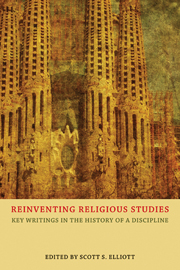Book contents
- Frontmatter
- Contents
- Introduction
- 1 For such a time as this: the Council of Societies for the Study of Religion, 1969–2009
- Part I Inventing and reinventing the field of religious studies
- Part II Method and theory in religious studies
- 9 Neutrality in the study of religion
- 10 Assessing social-scientific theories of religion
- 11 Playing hardball in religious studies
- 12 The academic study of religion: a methodological reflection
- 13 Fending off the social sciences
- Part III Teaching religion
- Part IV Women and the bible in religious studies
- Part V Religion and religious studies in civic life
- Part VI Religious studies and identity politics
- Part VII Islam and 9/11
- Bibliography
- Acknowledgments
- Index
12 - The academic study of religion: a methodological reflection
from Part II - Method and theory in religious studies
- Frontmatter
- Contents
- Introduction
- 1 For such a time as this: the Council of Societies for the Study of Religion, 1969–2009
- Part I Inventing and reinventing the field of religious studies
- Part II Method and theory in religious studies
- 9 Neutrality in the study of religion
- 10 Assessing social-scientific theories of religion
- 11 Playing hardball in religious studies
- 12 The academic study of religion: a methodological reflection
- 13 Fending off the social sciences
- Part III Teaching religion
- Part IV Women and the bible in religious studies
- Part V Religion and religious studies in civic life
- Part VI Religious studies and identity politics
- Part VII Islam and 9/11
- Bibliography
- Acknowledgments
- Index
Summary
This is how I assess the situation. There is, first of all, the reductionistic approach to the study of religion. The assumption here seems to be that religion can be fully explained in terms of social, psychological, and other factors. As the “scientist” peels the layers of the onion one by one, as it were, religion is stripped of all its constructs and when everything has been explained about religion one discovers that it has itself been explained away and there is nothing left in the end.
Then there is the non-reductionistic approach to the study of religion. On this view the social, political, psychological, and other dimensions of religion are not denied but what is denied is the claim that religion can be reduced to these. Religion is something more. An analogy might help. It is not possible to see without light, but vision is not a property of light but of the eye. Similarly, religion perhaps cannot exist without being implicated in social, cultural, historical, and other matrices, but that it cannot exist without them does not mean that it can be reduced to them—it retains a uniqueness all its own.
Ultimately the contrast between the reductionistic and the non-reductionistic approaches turns on this element of uniqueness in religion, denied in one approach and admitted in another.
Now if its existence is admitted then the question arises: how does one gain access to this element? On this point the position articulated by W. B. Kristensen is well-known—that “we must refer exclusively to the believer's testimony.”
- Type
- Chapter
- Information
- Reinventing Religious StudiesKey Writings in the History of a Discipline, pp. 83 - 85Publisher: Acumen PublishingPrint publication year: 2013



